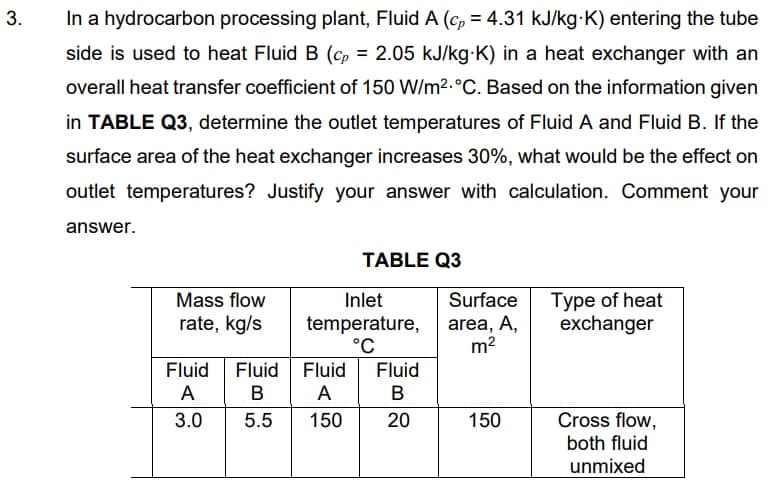In a hydrocarbon processing plant, Fluid A (cp = 4.31 kJ/kg K) entering the tube side is used to heat Fluid B (cp = 2.05 kJ/kg-K) in a heat exchanger with an overall heat transfer coefficient of 150 W/m2.°C. Based on the information given in TABLE Q3, determine the outlet temperatures of Fluid A and Fluid B. If the surface area of the heat exchanger increases 30%, what would be the effect on outlet temperatures? Justify your answer with calculation. Comment your answer. TABLE Q3 Type of heat exchanger Mass flow Inlet Surface temperature, area, A, °C rate, kg/s m2 Fluid Fluid Fluid Fluid A A B 3.0 5.5 150 20 150 Cross flow, both fluid unmixed
In a hydrocarbon processing plant, Fluid A (cp = 4.31 kJ/kg K) entering the tube side is used to heat Fluid B (cp = 2.05 kJ/kg-K) in a heat exchanger with an overall heat transfer coefficient of 150 W/m2.°C. Based on the information given in TABLE Q3, determine the outlet temperatures of Fluid A and Fluid B. If the surface area of the heat exchanger increases 30%, what would be the effect on outlet temperatures? Justify your answer with calculation. Comment your answer. TABLE Q3 Type of heat exchanger Mass flow Inlet Surface temperature, area, A, °C rate, kg/s m2 Fluid Fluid Fluid Fluid A A B 3.0 5.5 150 20 150 Cross flow, both fluid unmixed
Principles of Heat Transfer (Activate Learning with these NEW titles from Engineering!)
8th Edition
ISBN:9781305387102
Author:Kreith, Frank; Manglik, Raj M.
Publisher:Kreith, Frank; Manglik, Raj M.
Chapter7: Forced Convection Inside Tubes And Ducts
Section: Chapter Questions
Problem 7.54P
Related questions
Concept explainers
Heat Exchangers
Heat exchangers are the types of equipment that are primarily employed to transfer the thermal energy from one fluid to another, provided that one of the fluids should be at a higher thermal energy content than the other fluid.
Heat Exchanger
The heat exchanger is a combination of two words ''Heat'' and ''Exchanger''. It is a mechanical device that is used to exchange heat energy between two fluids.
Question

Transcribed Image Text:In a hydrocarbon processing plant, Fluid A (cp = 4.31 kJ/kg-K) entering the tube
side is used to heat Fluid B (cp = 2.05 kJ/kg-K) in a heat exchanger with an
overall heat transfer coefficient of 150 W/m2.°C. Based on the information given
in TABLE Q3, determine the outlet temperatures of Fluid A and Fluid B. If the
surface area of the heat exchanger increases 30%, what would be the effect on
outlet temperatures? Justify your answer with calculation. Comment your
answer.
TABLE Q3
Type of heat
exchanger
Mass flow
Inlet
Surface
rate, kg/s
temperature,
°C
area, A,
m2
Fluid
Fluid
Fluid
Fluid
A
в А
B
3.0
5.5
150
20
150
Cross flow,
both fluid
unmixed
3.
Expert Solution
This question has been solved!
Explore an expertly crafted, step-by-step solution for a thorough understanding of key concepts.
Step by step
Solved in 2 steps with 2 images

Knowledge Booster
Learn more about
Need a deep-dive on the concept behind this application? Look no further. Learn more about this topic, mechanical-engineering and related others by exploring similar questions and additional content below.Recommended textbooks for you

Principles of Heat Transfer (Activate Learning wi…
Mechanical Engineering
ISBN:
9781305387102
Author:
Kreith, Frank; Manglik, Raj M.
Publisher:
Cengage Learning

Principles of Heat Transfer (Activate Learning wi…
Mechanical Engineering
ISBN:
9781305387102
Author:
Kreith, Frank; Manglik, Raj M.
Publisher:
Cengage Learning